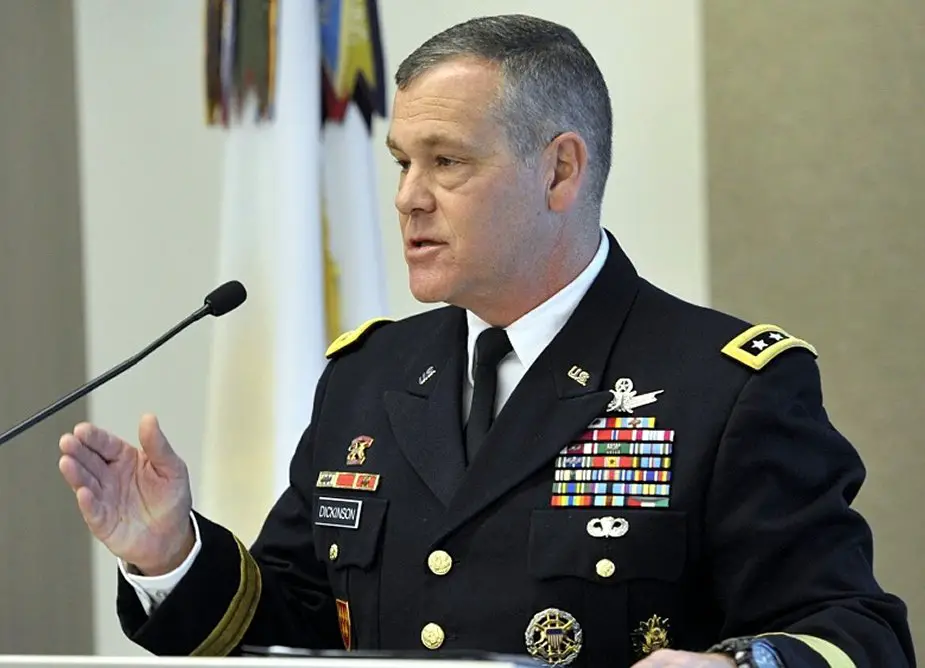US Army senior air defender talks future of air, missile defense
The U.S. Army's senior air defender talked about current and future developments in the air and missile defense, or AMD, with senior military leaders during an Association of the United States Army professional development forum March 12. Jason Cutshaw (SMDC/ARSTRAT) reports on U.S. Army’s website.

Lt. Gen. James H. Dickinson, commanding general, U.S. Army Space and Missile Defense Command/Army Forces Strategic Command, addresses the Association of the U.S. Army's Hot Topic: Army Air and Missile Defense symposium at the General Gordon R. Sullivan Conference and Event Center in Arlington, Va., March 12. (Photo Credit: Jason Cutshaw (SMDCARSTRAT))
Lt. Gen. James H. Dickinson, commanding general, U.S. Army Space and Missile Defense Command/Army Forces Strategic Command, addressed the forum entitled, "Army Space and AMD: Enabling Force Lethality in Multi-Domain Operations," at the General Gordon R. Sullivan Conference and Event Center in Arlington, Virginia.
"We understand that our potential adversaries have made technological advances in nearly every capability in the past few decades," Dickinson said. "In this strategic environment of great power competition, China, Russia and other competitors are working every day to develop and field air and missile defense capabilities with greater mobility, range, speed and precision.
"Across the Department of Defense capability development community, we understand that we can't continue doing the same thing, in the same way, at the same pace, and expect to maintain our technological advantage," he added.
The soon to be published Army AMD 2028 articulates what must be accomplished in future operational environments to achieve modernization initiatives. "Army AMD 2028 will define the vision for the future Army AMD force and outline the ends, ways and means required to achieve it," Dickinson said. "We have four lines of effort, or ways, essential to our success. We will ensure that we have the right capabilities to meet the multi-domain threat; we have the necessary capacity; we sustain our readiness with the best people and training, as well as adaptable formations; and are interoperable and integrated to the greatest extent possible with each other and our allies and partners."
He said the Army AMD 2028 framework is nested with the National Security Strategy and National Defense Strategy, the Missile Defense Review and the Army Vision and Army Strategy, and will continue to advance the Army's ability to defend the force in multi-domain operations.
Dickinson discussed where AMD solutions will be integrated into multi-domain operations to address the broad and expanding threat set. He said kinetic threats range from air and land platforms from small unmanned aircraft systems to ballistic cruise missiles, hypersonic weapons, as well as non-kinetic threats like electronic warfare and cyberattacks.
"Our advantage is a significant factor in deterrence," he added. "Multi-domain operations acknowledges that we are in competition with potential adversaries at all times. If the enemy can outpace our speed and innovation, it affects not only our warfighting but also our deterrent strength."
Dickinson said the Army is implementing bold changes and that Army AMD is a crucial part of the Army's transformation. He emphasized it is one of the pillars on which the Army of 2028 will develop and how the Army's maneuver force of 2028 needs an AMD force with the right capabilities and capacity defending it.
"We need capabilities against the full threat to minimize risk to Army and joint forces, allies and partners," Dickinson said. "The AMD force of 2028 must be many things such as agile, rapidly tailorable, scalable and able to fight multiple, complex and integrated attacks. To achieve that, we have to optimize our formations to see a mix of capabilities, integrated at all echelons. This is how we will achieve a layered defense in depth for the maneuver force in multi-domain operations.
"In the future, we can expect to see a mix of capabilities integrated at all echelons," he added. "There is no one silver bullet for a rapidly changing and complex threat set. We have to further diversify the portfolio with an assortment of capabilities to counter the threat."
He said as the Army builds toward this AMD vision, fiscal constraints are a key consideration and the service has to make every dollar count. "We need more cost-effective options in the capability portfolio," Dickinson said. "The available technologies have changed so we need to look at a wider range of solutions. As leaders, we need to continually encourage speed and innovation. We have to allow people to take risks," he added. "When it comes to innovation, there is a lot of untapped potential throughout our capability development community. We can encourage a culture in which people are expected to think, judge, decide and act."
The general said the Army is the largest military user of space and that this always surprises people, even though a typical brigade combat team has at least 2,500 pieces of space-related gear and at least 250 satellite communication-enabled devices. "When we shoot, move and communicate, we use space," Dickinson said. "We use space for missile warning; command, control and communications; situational awareness; precision, navigation and timing; and friendly force tracking. Our space capabilities and applications are integral to so much that we do. We must integrate space considerations into our planning and training."
In closing, he addressed international cooperation and interoperability by saying it is a critical warfighter priority that we are interoperable and integrated with allies and partners to the greatest extent possible in plans, policies and authorities.
"Everyone here knows we don't fight alone," Dickinson said. "Our active defense capacity is finite. To maximize our lethality we must integrate our allies and partners into a common and mutually supportive architecture. We must continue to work with them to increase integration, and capability and capacity so that we can share the burden of common defense."


























